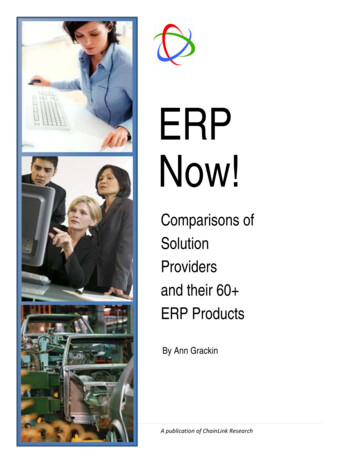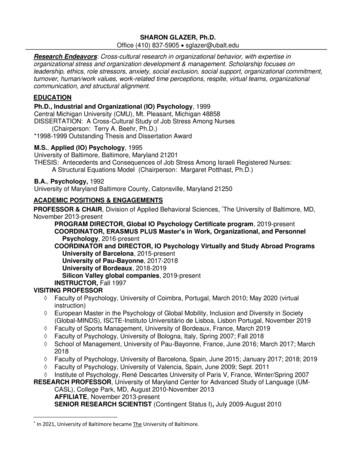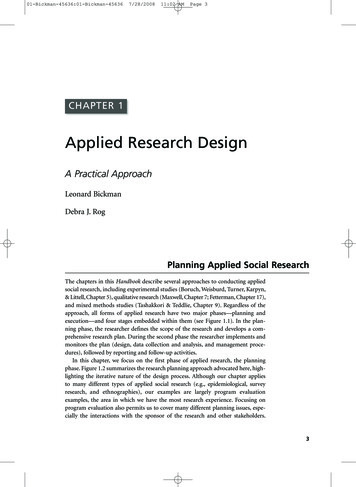
Transcription
ERPNow!Comparisons ofSolutionProvidersand their 60 ERP ProductsBy Ann GrackinA publication of ChainLink Research
ContentsIntroduction . 1ERP Providers by Company Size . 2New Kids On the Block . 7Turnarounds . 7The Industry View . 8Do I Pick a Package, a Company, or a Platform?. 8Cloud vs. On Premise . 10Conclusion—What about the Price? . 11Final Thoughts . 12Appendix One—ERP Firms Included in this Report . 13Appendix Two—References for Further Reading . 14
IntroductionWhat a time for ERP! New solutions providers and merger mania have kept this market from being dull. Andnew technologies—social, mobile and cloud—are the must-have capabilities that keep solutions fresh forexisting customers, as well as attract a new generation of customers.More than 65 packages are profiled in this report, and we know there are more out there. Amazingly, our globaleconomy can support a rich assortment of solutions. And although the number of ERP provider companies hasshrunk (for now), the number of ERP users continues to grow, as ERP providers embrace SMBs, even the smallestcompanies. Interestingly, the big players with multiple ERP products—Aptean, Epicor, Infor, Oracle and SAP,who have acquired ERPs through various mergers—have not retired those solutions. They have, or plan toupdate them, preserving your—the user’s— software investment. But that does not mean that from time totime you shouldn’t look elsewhere for new providers. When it’s time for a major upgrade, most companies staywith the initial provider. However, companies of all sizes do change ERP providers when a major changehappens.In this short report we are highlighting a few important aspects of the ERP companies in the market: Target-company size—Large, Midsize or Small EnterpriseThe industry for which the solution is designedThe delivery platform—on premise, hosted, or cloudWe have chosen the above criteria because in talking to hundreds of users, their initial filtering process focuseson those three issues. That said, there is so much to understand about ERP providers, and we’ve written aboutmany of them (which you can read on our website).For example, there are some incredible, competitive solutions in markets like manufacturing or distribution. Aswell, there are ERPs for specialty markets such as auto parts, cell phone, or hardware retailers; plumbing supplycompanies; paper mills; or senior living facilities. These are sectors and subsectors the general providers oftendon’t think about. These specialties are big enough markets, though, to warrant continued investment insoftware design and sales; although some of their requirements are unique to their industry only. Often thesenuances are left out of a general package. So it is worth your while, as the technology buyer, to check industryfocus as a key filter in your selection criteria. We provide a table comparing offerings by industry in this report.What is also interesting is the number of new companies—new startups with code written from scratch—entering into underserved markets like retail or construction. In addition, markets that had little presence inERP— such as retail and healthcare—are getting some attention today. There is a thriving market for originalsales.Some long-term players have had financial or technology facelifts, so there are a few interesting turnaroundstories to tell, which we will discuss within this report (you can also read more about this at our ERP researchpage.)This report does not provide specific vendor evaluations or scores, nor does it comment on the quality of thesesolutions. Its goal is to provide, in one place, a fairly complete picture of who is in the market, their solutions,and to whom they sell. In this report we are going to keep it simple.1 Page
ERP Providers by Company SizeSo who are the providers we have been mentioning? Today, there is quite a range of ERP providers, with somany products.Table 1 on the next page shows a list of theproviders in this space. Some providers aredifferentiated by small- vs. medium-sizedbusinesses. This table also covers on premise,hosted, and cloud solutions. We define cloudas a multi-tenant type of solution, i.e. singleinstance multi-tenant/single release—thismeans all customers are on the same releaseand multiple customers may share the sameinstance of the software. There are variantson multi-tenant, as well, with highlyconfigurable approaches. Definitions ofCloud/SaaS differ from on demand, whichrequires little upfront technical work and hasa variety of payment options.Hosting, according to our definition, 1 is not categorized as cloud (although you may access your software overthe web). However, many providers do call themselves cloud. Hosting has your version of the software, just asan on premise solution would, but in another location, managed by a third party. The distinction is importantsince these criteria affect customization and the cost of these solutions.As you will see in Table 1, we are immediately confronted with a daunting list of players. It’s critical tounderstand that the larger firms like Sage, SAP, and Infor have multiple product offerings that are either industryor company-size oriented solutions. Some of these also are designed for growth, so as you grow you don’t haveto buy a new package. NetSuite, Plex and SAP’s All-in-One are some examples. For example, a small, lesscomplex business might adopt SAP BusinessOne; whereas a business destined for growth would purchase All-inOne and add functions as they grew.Plex and NetSuite provide this same concept without thepurchasing confusion, we think. Highly configurable, multitenant architectures allow users to adopt business processes asneeded without guessing which software package might be theone they need. Today, many ERP firms have businessconsultants who work with their clients to ensure that theychoose the right solution.1You can get definition of license vs. SaaS here, definition of service platforms here and On Demand vs. other types of SaaS2 Page
Company size byemployeesAspen TechAptean-AxisAptean CompiereAptean CimnetAptean DTRAptean EncompixAptean Envision XERPAptean Empower ERPAptean IntuitiveApteanMade2ManageAptean RelevantAptean Ross ERPBizSlate ERPBlueLinkCincomUltraSmall1-10 Small10-50Small-Mid50100 Mid100500MegaMid 500Subsidiary LE OnPremise Hosted Table 1-A: ERP Providers3 PageMultiTenantSaaS CommentsFor heavy process industries (mainly Petrochemical); engineering andconstructionERP system for the Metals, Wire and Cable industriesOpen-source stack (e.g. Java, Linux, JBoss, Postgres); utilizes abrowser-based AJAX UI based on the Google Web ToolkitDesigned for electronics global business model: outsourced, yetintegrated processes from design through manufacturingPlastic manufacturing solution with multi-mode: process throughdiscrete manufacturing processProject-based and engineer-to-order businesses—from quotingthrough service managementERP built for trading companies. The solution supports multicompany, multi-location, multi-currency operationFor discrete manufacturers in the Asian Pacific who face uniquechallenges, from accounting regulations to production modesRich ERP stack for regulated discrete manufacturing (such asAerospace and Defense)ERP known for strong manufacturing execution—scheduling, control,and quality on the shop floor; a major platform upgrade to .NET inversion 7.0 and beyondEngineer-to-order for industries such as Aerospace &Defense; hassome larger Fortune 200 enterprise customersRegulated process industries; stong supply chain; and track and traceWeb-based or on premise for Wholesale Distributors, Small Appareland Brand Companies, Small Retailers—sales and marketing modulesincludedMarketed as the “upgrade from QuickBooks”; Canadian headquartersPartnership with Microsoft for small-market customers; one of theearlier MRP/ERP’s in the market ( 30 yrs); focus on complexmanufacturing
Company size byemployeesEpicor Prophet 21Epicor EclipseEpicor ERPEpicor ExpressEpicor EagleEpicor CatalystEpicor PreludeEpicor VisionEpicor Retail SuiteEpicor Retail SaaSHarrisData ERP forManufacturingHarrisData ERP forDistributorsIFSInfor SyteLineInfor VISUALInfor LN4 PageUltraSmall1-10 Small10-50Small-Mid50100 Mid100500 MegaMid 500 Subsidiary LE OnPremise Hosted Table 1-B: ERP ProvidersMultiTenantSaaS CommentsSoftware targeted at Industrial, Fluid Power, Fasteners, MedicalSupplies, HVAC, Paper, Packaging, JanSan, Tile, and Petroleumdistributors, with customers in many other distribution marketsDesigned for Electrical, Plumbing, and HVAC wholesalers, withcustomers in many other distribution markets9.5 will offer any delivery platform—E9 has a multi-tenant cloudversionCloud-based on-demand full ERP for Distribution businessesERP for small- to medium-sized retailers focused on eight specificspecialty retail sectorsERP for Lumber and Building Materials Dealers—retail anddistribution businesses—has POS, inventory management, etc.Large enterprise Wholesale Distribution focus—includes servicemanagement/repair, rentalsSolution for Automative Aftermarket business—focus on warehouseand parts distributionLE and mid-sized enteprises—customers who are too large for Eagleare advised to purchase Retail SuiteSmall- to mid-sized cloud retail solution includes POS, Merchandising,FinancialCloud platform will be upgraded in late 2012; HRIS is focused at midand large-sized companies; new UI across productsCustomers can buy modular solutions such as HR (link to my harrisdata article) or CRMCloud service for tracking, asset management, service managementERP for industrial, engineer-to-order and discrete manufacturers thathave follow-on servicesERP for small, but manufacturing-intensive enterprisesMega-mid and large enterprise focus; for complex manufacturing,distribution and service industries; strong MRP and global accounting
Company size byemployeesInfor LXInfor XAInfor AdageInfor System 21Infor (Lawson)FinancialManagement (S3)Infor M3 (Lawson)iQmetrixIQMSKenandyMicrosoftDynamics GPMicrosoftDynamics AXMicrosoftDynamics NAVMyERPNetSuiteNetSuite OneWorldNetSuite OpenAir5 PageUltraSmall1-10 Small10-50Small-Mid50100 Mid100500 MegaMid 500 Subsidiary LE OnPremise Hosted Table 1-C: ERP ProvidersCommentsMultiTenantSaaS Designed to run on IBM System i Series, for mid-size business forprocess industriesDesigned to run on IBM System i Series for mid-sized business fordiscrete with mixed-mode processes including repetitive and ‘toorder’ manufacturingProcess industries—food, beverage and chemicalsAn ERP global solution for complex mixed-mode or distributionincluding apparel, automotive, food/beverage, electronic and otherindustries; can run on IBM System i seriesHealthcare and Life SciencesFood & Beverage; equipment, chemical manufacturing anddistributionRQ4 Retail Management is an ERP for small retailers, including POS.Designed especially for wireless retailersManufacturing-centric ERP for mid-market; IQMS is known for itsMES and quality systems; built in MS Windows, runs on OracledatabaseBuilt on force.com platform; a version 2.0 just releasedNot multi-tenant in core ERPIndustry-specific ERP; CRM is multi-tenantFor small and mid-sized businesses. Not multi-tenant in core ERPBased on Google tools—uses Google marketplace for sales; free–tofeeCloud solution; ERP, CRM, eCommerce integrated on single databaseand architectureAdds multi-currency, multi-language, multi-time to NetSuiteProfessional Services automation with Project/Resource management& accounting, timesheet, expense
Company size byemployeesOracleE-Business SuiteOraclePeopleSoft EnterpriseOracle FusionPlexQADSAGE ONESAGE X3SAGE 100 ERPSAP All-in-OneSAP Business OneSAP BusinessByDesignSAP ERP 6.0SYSPROUNIT4 AgressoBusiness WorldVisibility6 0MegaMid nts Not multi-tenant; small businesses are most often served by partnernetworkNot multi-tenant; for fast-growing companies on limited budge
Infor VISUAL ERP for small, but manufacturing-intensive enterprises . Infor LN Mega-mid and large enterprise focus; for complex manufacturing, distribution and service industries; strong MRP and global accounting . Table 1-B: ERP Providers . 5 Page. Company size by employees. Ultra Small . 1-10 : Small . 10-50 . Small-Mid 50-100 : Mid . 100-500 : Mega-Mid 500 : Sub-sidiary . LE On-Premise .











